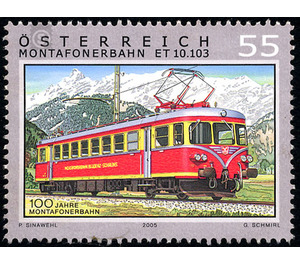railroad - Austria / II. Republic of Austria 2005 - 55 Euro Cent
Theme: Traffic, Transportation & Mobility
| Country | Austria / II. Republic of Austria |
| Issue Date | 2005 |
| Face Value | 55.00 |
| Edition Issued | 700,000 |
| Printing Type | combination printing |
| Stamp Type | Commemorative |
| Item Type | Stamp |
| Chronological Issue Number | 1890 |
| Chronological Chapter | OOS-OE2 |
| SID | 371482 |
| In 55 Wishlists | |
The Montafonerbahn opens up one of the most beautiful mountain regions in Vorarlberg. From the Montafon, where in some remote mountain valleys is still spoken Romansh, one reaches the snow-covered glacier region of the Silvretta with the highest peak of Piz Buin (3312m). The 13 km long route leads from Bludenz through the valley of the Ill up to Schruns, the main town of the valley. Private initiatives of the citizens of Montafon laid the foundations for railway construction and energy supply at the beginning of the last century. Just one year after the concession, the railway was opened on 16 December 1905. It was the first electrically operated standard gauge railway in the monarchy. With the construction of this railroad, tourism entered the valley, and industry and commerce took a visible boost. The company Montafonerbahn suffered many setbacks due to natural disasters, especially floods, it had to survive two world wars, but it remained an indispensable part of the valley. The economic upswing from the beginning of the sixties required a comprehensive modernization program: the technical upgrading in the plant and energy sector and in passenger transport. On May 20, 1965, the new dual-current railcar ET 10.103 was put into operation. It was the best gift for the 60th anniversary. The old diesel railcar VT 63.905 became an elegant railcar in yellow-red livery. It was equipped with half-condescending windows, two-winged entrance doors, modern frontage, a 1st class compartment and had a total of 60 seats. The service weight was 40 t with a car length of 22 m. Special pieces played the electrical equipment. It consisted of an electronic cruise control, a 750 volt DC system, two 150 kW Tatzlagerfahrmotoren and a 15 kV AC power for 16 2/3 Hz. This was necessary for the entrance to the station Bludenz, since the Arlberg route was operated with alternating current. The new railcar was designed for a top speed of 100 km / h, making it the fastest railcar of all Austrian private railways and the first DC / AC vehicle in Austria. The pride of the Montafonerbahn has been sent on special trip several times, including to Switzerland and Germany. Today, Montafonerbahn AG secures energy in the region through its hydroelectric power plants, traffic with rail and bus lines and offers technical and telecommunications services. Structural problems as a result of the competition between road and private transport are compensated for by special offers, such as the introduction of a Schizuges or Nachtexpresszuges, or the lowering of the journey time from once 50 minutes to 20 minutes today. There are around 50 trains a day, with 1.1 million passengers being transported each year and around 250,000 tonnes of goods transported. A 100 years young train: modern, fast, uncomplicated.


